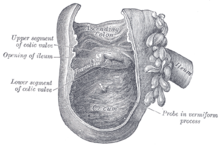Ileo-caecal valve

The ileocecal valve or ileocaecal valve ( Latin Valva ileocaecalis ) is a functional closure between the large and small intestine . It bulges in the right lower abdomen as an invagination of the last part of the ileum ("ileum") into the large intestine. Under the Basel anatomist Caspar ileocecal (1560-1624) it is also called ileocecal valve or Bauhin'sche flap called.
Layout and function
Originally, a distinction was made between an upper lip ( labrum ileocolicum or superius ) and a lower lip ( labrum ileocaecale or inferius ). However, endoscopic examinations have shown that the ileocecal valve in living humans is round and has no lips. The lips are an artifact that only arises when a person dies.
The ileo-caecal valve serves as a functional seal between the large and small intestines and is normally only passable in the direction of the large intestine, in that when the intestine is stretched, a valve-like mechanism prevents intestinal contents - and with this bacteria - from penetrating the significantly less germ-free end section of the ileum.
The protuberance of the large intestine below the ileocecal valve is located caecum ( cecum known) and carries at its lower pole the appendix ( vermiform appendix ).
Diseases
There are no diseases as such that are restricted to the colon valve. However, inflammation of the small, large and appendix can spread to the Bauhin valve and lead to so-called Bauhinitis , for example due to Crohn's disease , ulcerative colitis or ileocecal tuberculosis . A Miserere may be the result. Large gallstones can also get caught there on their way to the colon and cause gallstone ileus . Tumors found in the digestive tract, such as B. neuroendocrine carcinoma ( carcinoid ) can of course also manifest themselves here. A defect in the valve can be the cause of an overgrowth in the small intestine .
Individual evidence
- ↑ Petra Köpf-Maier: Wolf Heidegger's Atlas of Human Anatomy . 6th edition. Verlag Karger, Basel 2004, ISBN 3-8055-7663-3 (Volume 2), p. 195.
- ^ Guder WG: Das Laborbuch für Klinik und Praxis , Urban & FischerVerlag, 2005, p. 202, ISBN 3437233408 , here online .
